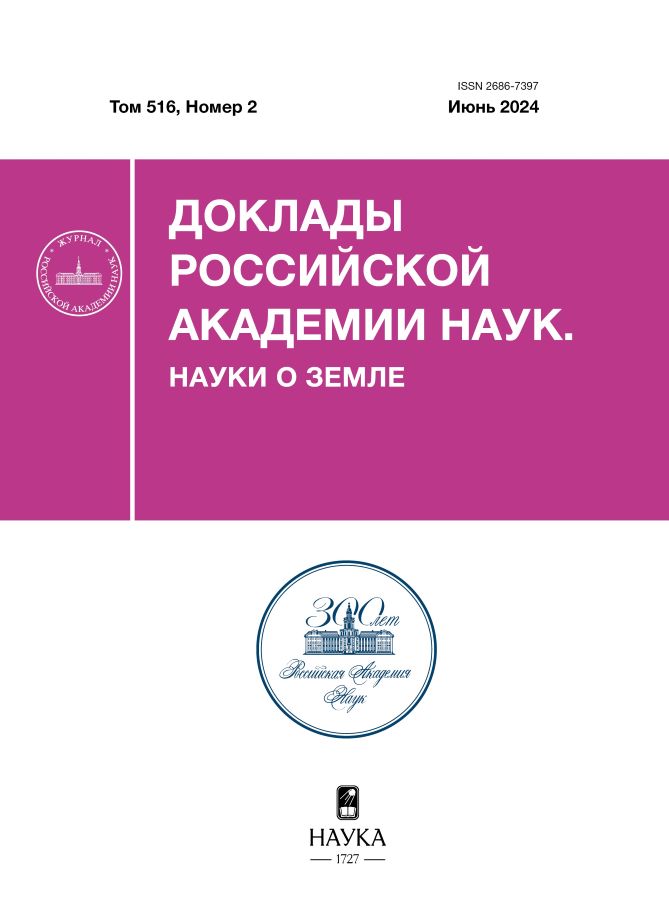REE mineralization in alkaline rhyolites of the Pechalninsky ore field (North-East of Russia)
- 作者: Grigorieva A.V.1, Volkov A.V.1, Sidorova N.V.1
-
隶属关系:
- Institute of Geology of Ore Deposits, Petrography, Mineralogy and Geochemistry of the Russian Academy of Sciences
- 期: 卷 516, 编号 2 (2024)
- 页面: 593-599
- 栏目: MINERALOGY
- ##submission.dateSubmitted##: 31.01.2025
- ##submission.datePublished##: 12.12.2024
- URL: https://edgccjournal.org/2686-7397/article/view/650047
- DOI: https://doi.org/10.31857/S2686739724060114
- ID: 650047
如何引用文章
详细
For the first time (by methods Scanning Electron microscopy, X-ray spectral microanalysis and cathodoluminescence method) REE mineralization studies have been conducted in alkaline rhyolites of the Pechalninsky ore field (North-East of Russia), a potentially larger-volume source of HREE. It is shown that in the direction of fluidity, thin interlayers composed of crystalline aggregates of pyroxenes and/or amphiboles impregnated with a silicate substance alternate in the rock, and ribbon-like thin strips and lace separations of Fe, Ti, and Mn hydroxides that have replaced titanomagnetite (relict secretions of which are partially preserved). Microcrystalline aggregates of pyroxenes and/or amphiboles contain the finest inclusions of REE secretions (5–7 microns), the determination of mineral species of the latter is difficult due to the small particle sizes. Scanning electron microscopy (EMF) has determined that these secretions are REE phosphates. Concentrically zonal and radially radiant REE secretions have been revealed in the relics of titanomagnetite crystals. The first ones are represented by silicates enriched with Yt and REE. In them, the content of REE varies unevenly from the center to the edge. Radially radiant aggregates are represented by oxides and/or carbonates containing REE (La, Ce and Nd predominate). The results obtained can be used in the development of enrichment technology.
全文:
作者简介
A. Grigorieva
Institute of Geology of Ore Deposits, Petrography, Mineralogy and Geochemistry of the Russian Academy of Sciences
编辑信件的主要联系方式.
Email: grig357@mail.ru
俄罗斯联邦, Moscow, 119017 Moscow, Staromonetny per., 35
A. Volkov
Institute of Geology of Ore Deposits, Petrography, Mineralogy and Geochemistry of the Russian Academy of Sciences
Email: grig357@mail.ru
Corresponding Member of the Russian Academy of Sciences
俄罗斯联邦, Moscow, 119017 Moscow, Staromonetny per., 35N. Sidorova
Institute of Geology of Ore Deposits, Petrography, Mineralogy and Geochemistry of the Russian Academy of Sciences
Email: grig357@mail.ru
俄罗斯联邦, Moscow, 119017 Moscow, Staromonetny per., 35
参考
- Волков А. В. Галямов А. Л., Мурашов К. Ю. Щелочные риолиты Печальнинского рудного поля (Северо-Восток России) – потенциальный большеобъемный источник тяжелых редкоземельных элементов // Доклады РАН. Науки о Земле. 2023. Т. 510. № 1. С. 46–51.
- Государственная геологическая карта Российской Федерации. Масштаб 1:1000000 (третье поколение). Серия Верхояно-Колымская. Лист Р-56 – Сеймчан. Объяснительная записка. СПб.: «ВСЕГЕИ», 2008. 426 с.
- Егоров В. Н., Жигалов С. В., Волков А. В., Сидоров А. А. О редкометальном оруденении в трахириолитах и комендитах Хурчан-Оротуканской металлогенической зоны // ДАН. 2005. Т. 405. № 2. С. 237–242.
- Кузнецов В. М. Строение, геодинамика и рудоконтроль Хурчан-Оротуканской зоны ТМА // Геологическое строение, магматизм и полезные ископаемые Северо-Востока Азии. Магадан, 1997. С. 50–52.
- Панычев И. А., Смирнов П. П. Геологическая карта СССР масштаба 1:200000. Серия Верхнеколымская. Лист P-56-XV. Объяснительная записка. Магадан, 1979. 110 с.
- Хубанов В. Б., Врублевксая Т. Т., Цыренов Б. Ц., Цыганков А. А. Процессы фракционной кристаллизации и смешения магм в формировании трахибазальт-трахитовой бимодальной серии Мало-Хамардабанской вулканотектонической структуры, юго-западное Забайкалье // Петрология. 2015. Т. 23. № 5. С. 490–520.
- Agangi A., Kamenetsky V. S., McPhie J., The role of fluorine in the concentration and transport of lithophile trace elements in felsic magmas: insights from the Gawler Range Volcanics. South Australia // Chem. Geol. 2010. V. 273. P. 314–325.
- Jowitt S. M., Medlin Ch. C., Cas R. A. F. The rare earth element (REE) mineralisation potential of highly fractionated rhyolites: A potential low-grade, bulk tonnage source of critical metals // Ore Geology Reviews. 2017. V. 86. P. 548–562. https://doi.org/10.1016/j.oregeorev.2017.02.027
- Miller C. F., Mittlefehldt D. W. Depletion of light rare-earth elements in felsic Magmas // Geology. 1982. Vol. 10. P. 129–133.
- Price J. G., Rubin J. N., Henry C. D., Pinkston T. L., Tweedy S. W., Koppenaal D. W. Rare-metal enriched peraluminous rhyolites in a continental arc, Sierra Blanca area, Trans-Pecos Texas; chemical modification by vapor-phase crystallization: Ore-bearing granite systems; petrogenesis and mineralizing processes // Geol. Soc. Am. 1990. Special Paper 246. P. 103–120.
- Yan Sh., Niu H.-C., Zhao X., Zhang Q.-B., Zhang H.-J., Zhao X.-Ch. Rare metal enrichment of the Tianbao trachytic complex, North Daba Mountains (South Qinling): Insights from textures and geochemistry of trachytes and Nb-REE minerals // Ore Geology Reviews. 2022. V. 146. 104948. https://doi.org/10.1016/j. oregeorev.2022.104948.
补充文件














